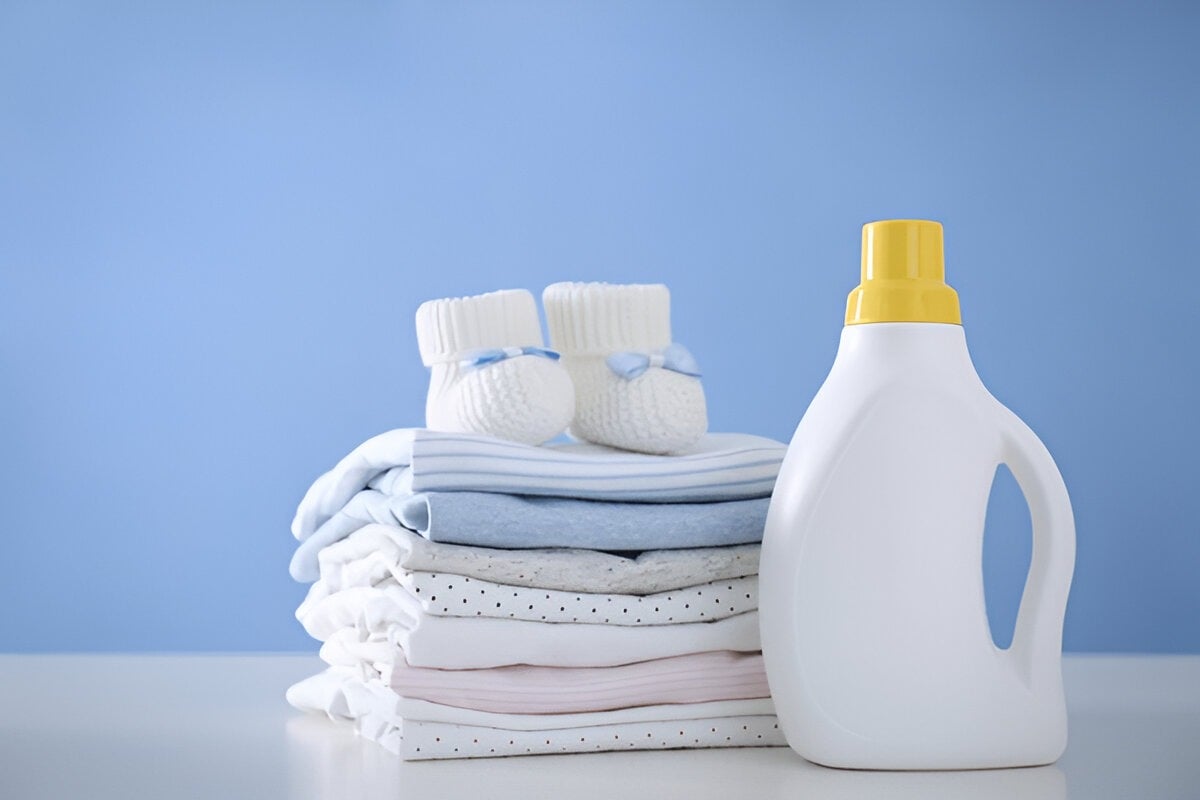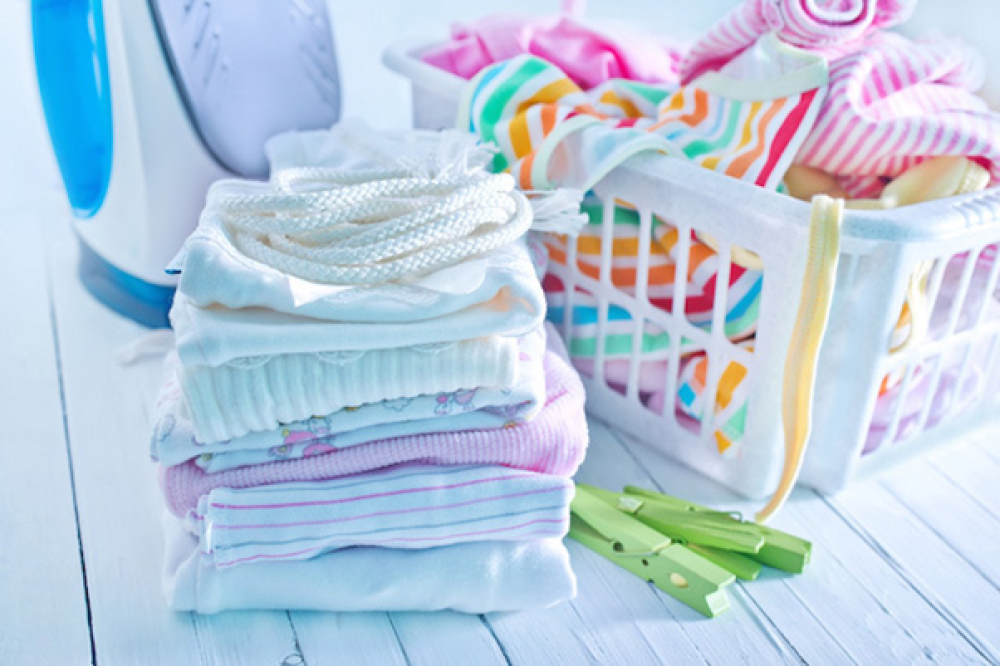Washing baby clothes is not just a regular cleaning process, it is a necessary procedure to maintain their delicate skin. Baby clothes require special treatment due to their extreme sensitivity to chemicals and pollutants. Therefore, it is important to choose baby laundry soap carefully and follow the correct method to ensure that the clothes are clean without harming the baby's skin.
In addition, the cleanliness of clothes is one of the basic aspects that affect children's health, as germs and bacteria can accumulate on them, which may affect the child, especially in their early years, when their immune system is in the development stage. Building strong immunity depends on several factors, including proper nutrition, vaccinations, and personal and environmental hygiene.
In this article, we will provide some steps and tips to wash in the best way.
1. Choosing a laundry soap for children
Choosing the right laundry soap for your baby is an essential step to keeping their sensitive skin healthy, as some harsh chemicals can irritate the skin or cause allergies. So, it’s important to avoid regular laundry soap and use a baby-specific soap that’s free of any harmful ingredients.
However, experts advise rinsing clothes two or three times so that no soap residue remains. Therefore, it is recommended to put the washing machine on the triple rinse program to ensure this, and the clothes must be checked to make sure of this.

2- Sorting children's clothes before washing
Washing baby clothes may seem complicated at first, but with time it will become routine. The first step you need to take when washing is to divide the clothes and separate them from each other, and then read the instructions.
Read baby clothes washing instructions
Reading the instructions is an essential step in sorting clothes because sometimes there are instructions on how to handle clothes in special ways, such as washing in cold or hot water, and sometimes a type of baby laundry soap is recommended . Here, clothes with special instructions are separated by themselves so that they do not mix with the rest.
Separate white clothes from colored ones.
Clothes are separated and divided based on their colors. White clothes are washed alone so that the white is not affected by the colors of other clothes if they fade, and also because white clothes are washed at a different temperature than the temperature of regular clothes, so reading the instructions for washing children's clothes is an essential step.
As for colored clothes, they are divided into light-colored and dark-colored clothes, so that the light colors are not affected by the dark ones, which sometimes lose part of their dye during washing.
Here are some tips on how to sort clothes according to water temperature.
The right water temperature for washing baby clothes
When it comes to washing baby clothes, choosing the right water temperature plays an important role in keeping them clean, protecting baby’s delicate skin, and extending the life of fabrics. Some mothers may wonder: Is it better to wash in cold, warm, or hot water?
As we mentioned previously, the division of clothes is also based on the type of water used as follows:
Children's clothing is separated based on the type of water used.
Cold water:
Cold water (30°C or less) is the ideal choice in several cases:
To preserve colors: Children's clothes are full of beautiful colors and cheerful patterns, and cold water helps prevent colors from fading.
Delicate fabrics: Some baby clothes are made of delicate fabrics such as light cotton or wool, and hot water may cause them to be damaged or shrink.
To remove some types of stains: such as milk or blood stains, as hot water may set the stain instead of removing it.
To keep clothes soft: Some fabrics become rough or lose their softness when washed in hot water, which can cause discomfort to a baby's sensitive skin.
Hot water:
Warm (40-50°C) or hot (60°C or more) water is useful in some cases that require deep cleaning, such as:
Newborn Clothes: Newborns have a weak immune system, so it is preferable to wash their clothes with warm water to kill germs and bacteria.
Very dirty clothes: If your child has played in mud or eaten and left tough stains like chocolate and oils, warm water will help dissolve them and remove them easily.
Maintain cleanliness and sterilization: Underwear, towels, and bed linens need to be washed in warm or hot water to get rid of bacteria.
In cases of illness: If the child is sick or suffering from a cold, it is best to wash his clothes with hot water to get rid of germs and viruses.
However, caution must be exercised when using hot water to wash children’s clothes, because despite the benefits of hot water in sterilization, it may cause some problems for fabrics:
Clothing shrinkage : Some fabrics such as cotton and wool may shrink, making the clothing smaller than its original size.
Color Fading : High temperatures may cause children's clothes to lose their bright colors.
Making fabrics rough : Some fabrics may become less soft after repeated washing in hot water, which may cause irritation to the baby's skin.
3- Tough spots
The question that puzzles all mothers is how to remove stubborn stains?
Mothers suffer from difficult stains that stain children's clothes, especially since little ones are always exposed to dirt while playing or eating. But, don't worry! There are easy and safe ways to remove stains without damaging clothes or affecting your child's sensitive skin. Therefore, we advise you to:
Treat the stain immediately : The sooner you clean the stain, the easier it will be to remove.
Test the cleaner first on a small part of the fabric to make sure it does not cause damage.
Avoid direct hot water : Hot water may set some stains such as blood and milk instead of removing them.
Use safe, natural ingredients : such as white vinegar, baking soda, and lemon juice, as they are effective and safe for children.
4- Choosing the appropriate washing cycle
1- Suitable washing machine settings for children's clothes
When washing children's clothes, it is preferable to use gentle washing settings that protect fabrics from damage and efficiently remove dirt and germs.
2- Select extra rinse
Due to the sensitivity of children’s skin, residues of washing powder or detergent can cause skin irritation or allergies. Therefore, it is advisable to activate the “extra rinse” option in the washing machine to ensure that any detergent residue is removed, making the clothes safer and softer to wear. You can also add half a cup of white vinegar to the final rinse cycle to help remove any traces of soap and sanitize the clothes naturally.
5- Ways to dry clothes
Drying baby clothes properly is just as important as washing them, as the drying method can affect the softness and lifespan of the fabrics.
While a dryer is a quick and convenient option, frequent use can damage or shrink some fabrics. Natural drying, on the other hand, can be safer, especially when you follow the right techniques to protect clothes from damage. In this article, we will discuss the harms of the dryer, in addition to the best ways to dry children's clothes without damaging the fabric, whether using natural air or sunlight.
Electric dryer
The electric dryer is a suitable option for drying children's clothes, but it has damages that may affect some types of fabrics. If it is not used in the correct way. Therefore, it is preferable to follow the following instructions when using the dryer:
Set the temperature to low or medium to protect fabrics from shrinking or damage.
Use mesh laundry bags when drying small items such as socks and underwear.
Avoid drying 100% cotton clothes in the dryer, as they are prone to shrinkage.
Combine tumble drying and natural drying for best results.
Sun drying
The answer depends on the type of fabric; white and cotton clothes can be hung in the sun, where ultraviolet rays help kill bacteria and remove yellow stains. As for colored and dark clothes, it is better to hang them in the shade to avoid color change or fading over time.
Additional tips for drying baby clothes
When drying children's clothes, it is best to follow methods that maintain the elasticity of the fabrics and prevent damage, such as:
Hang clothes in a well-ventilated area away from direct sunlight.
Avoid hanging heavy clothes while they are wet, as this can cause the fabric to stretch and become misshapen.
Use clean cotton towels to absorb excess moisture before hanging clothes.
Ultimately, washing baby clothes is a task that requires special care to ensure they are clean and protect your little ones’ delicate skin. From choosing the right baby laundry soap to following the correct washing and drying methods, every step plays an important role in keeping your baby healthy and their skin comfortable. By following the above tips, you can ensure that your baby’s clothes are clean and safe, giving you peace of mind and keeping them comfortable every day.

